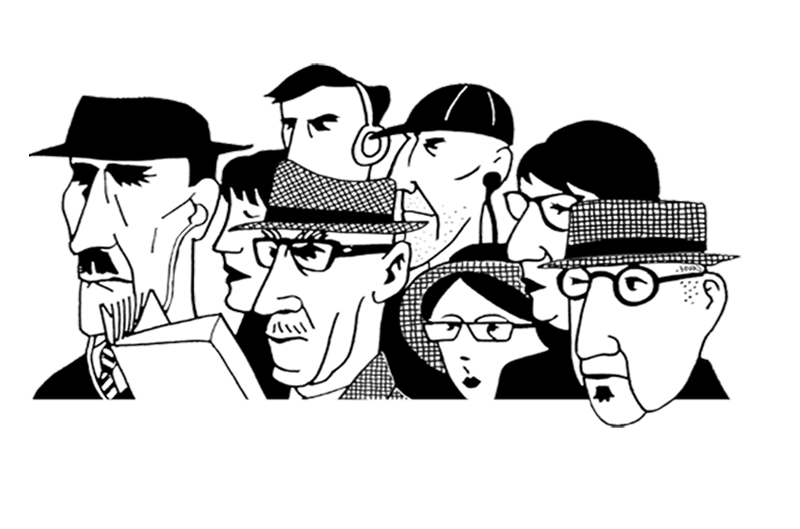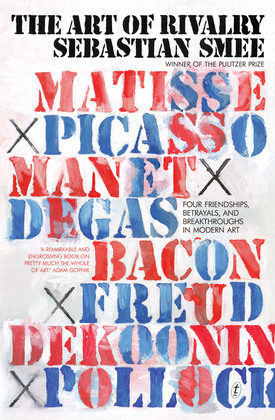Paris in Ruins: Love, War and the Birth of Impressionism
Sebastian Smee
Impressionism remains wildly popular. Crowds flock to exhibitions by its greatest artists: Édouard Manet, Berthe Morisot, Pierre-Auguste Renoir, Edgar Degas, Claude Monet, Camille Pissarro. But as Sebastian Smee shows in Paris in Ruins, a book of great narrative sweep and vivid detail, Impressionism was a complex reaction to an age of violence and war. From the summer of 1870 to the spring of 1871, the ‘Terrible Year’, Paris and its people were cut off, starved and forced to surrender by Germans—before rebel republicans established a breakaway government or Commune. After the burning of central Paris, the republicans were crushed by the French army.
Smee tells this story through the eyes of these key artists, with a special focus on the intimate, enigmatic relationship between Manet—the father of Impressionism—and Morisot, the group’s only female member in its early years. An indelible portrait of the city, Paris in Ruins captures the chaos of that year, and reveals how it had an incalculable effect on the development of modern art.
INTERVIEWS and REVIEWS
3MP: Great Australian Lives
ABC Radio National: Late Night Live
Another Mother Runner: 2024 Winter Reading
ArcaMax
Archyde
Art Newspaper
Article
Arts Canvas
ArtsHub: 12 spring – summer art book releases
ArtsHub (review)
Australian ($)
Australian Book Review
Australian Policy and History
Australian Writers’ Centre podcast: So You Want to be a Writer (from 0:16:50)
Author2Author podcast
Author Magazine
Chat10Looks3
Christian Science Monitor
Cultured Magazine
Daily Kos: Nonfiction Views: Two weeks worth of notable new nonfiction
GLAM Adelaide
Harvard Crimson: Sebastian Smee’s Impressions on Impressionism: Boston Book Festival Art History Keynote
InReview
Inside Story
John Batchelor Show (2:00:00)
Kirkus Reviews
Kirkus Reviews podcast
L.A. Times
Lavender Magazine
Literary Review
Lonely Palette podcast
Monthly podcast
New York Times
NZ Booklovers
Observer (US): Last-Minute Literary Gifts for the Art Lover On Your List
Otago Daily Times
Readings
Simply Luxurious Life: This & That
Sydney Arts Guide
Sydney Morning Herald
Telegraph (UK) ($)
World Today News: 12 Must-Read Art Books for the Holidays
Writer’s Bone: Friday Morning Coffee
andParis in Ruins
‘Astonishing. Heartstopping. A true story confined by two brutal years, and the walls of a great city under siege, which exults in love, courage, beauty, mischief and the mystery of human intimacy.’
‘Deft, vibrant cultural history.’
‘Its psychological insights into male friendship, ambition, ego and vulnerability make it a book as rich as a multi-layered cake.’
‘French Impressionist painting offers a vision of colour and light. And yet, there is an aspect to Impressionism that is dark, and that darkness is the preoccupation of this book. The rejection of authority of any kind as toxic was manifest in the way the Impressionists made their art. Paris in Ruins…well could change the way you think about Impressionism, and it might alter your perception of art history.’
‘Smee brings events to life vividly, with remarkable energy and insight…This raucous, layered and engrossing read left me reminded of the inseparable bond between politics and art.’
‘Very beautiful book. A marvellous mélange of military history, gossip, art criticism…The lot.’
‘Penetrating and arresting, Smee shows how the Paris Siege and the Paris Commune had an extensive effect on the history of art and how art can be inspired by disaster. For us artists and art lovers, this book is highly recommended.’
‘Smee has a gimlet eye, a seductive style and a novelist’s feel for character and incident…Deeply researched and suavely written…An inspiring book.’
‘Vibrant and incisive…Superb, scalp-tingling narration…Find[s] the luminosity at the movement’s heart and brilliantly [amplifies] it on the page.’
‘A wide-ranging work of cultural history.’
‘A story of staggering complexity and import…We have what may ultimately be regarded as [Smee’s] magnum opus, a work of art history that goes far beyond that remit…A fascinating story.’
‘Brilliant…Art and politics constantly collide in Smee’s pulsating narrative…Smee has a rare talent for painting word-pictures, notably in his superb descriptions of the salons, and a keen eye for revealing details…This is first-rate historical writing.’
‘A quite remarkable melange of art history, romance and political machinations…It was a vital, urgent time in Parisian history and Smee brings it vividly to life…Fascinating.’
‘4 stars. Readable and impeccably researched…For any lover of art history, it’s a compelling read…[An] outstanding achievement.’
‘Smee brings a fresh perspective by linking [the Siege of Paris and the Paris Commune] to the artistic development of Impressionism in general and of Manet and Morisot in particular…With exquisite sensitivity, he reads the similarities in [Manet and Morisot’s] work from this period…’
‘As for the larger story of the Impressionists, Smee suggests that their refusal to depict war may have constituted “a collective act of psychological repression” or “an assertion of pacific value as an antidote to violence and trauma”—or both…Better than reality, he argues, than the one that they and their compatriots had just endured.’
‘A precise, engrossing account of the artistic and military environment that preceded the emergence of the Impressionist movement.’
‘Detailed, lively and at times richly novelistic. Smee writes with both knowledge and panache, transmitting the sense of urgency and immediacy that animated the painters.’
‘Sebastian Smee explodes a tired chestnut about the Impressionists: that their works are merely pretty. Like a restorer scraping off layers of grime and dust, he restores colour and nuance and light, and performs the vital critical task of forcing us to look better and deeper at things we thought we already knew.’
‘The keynotes of Sebastian Smee’s criticism have always included a fine feeling for the what of art—he knows how to evoke the way pictures really strike the eye—and an equal sense of the how of art: how art emerges from the background of social history.’
‘4 stars. Readable and impeccably researched…For any lover of art history, it’s a compelling read…[An] outstanding achievement.’
‘An arresting tale…Smee brings to his task a wonderful eye and an engaging style that results in many insightful readings of the art he uses to illustrate the main points of his narrative.’
‘A book written in buoyant and accessible fashion…Paints subtle and intriguing portraits of Manet and Morisot…[Delineates events with] admirable clarity.’
‘[Sebastian Smee is] one of the world’s best art writers, but it turns out he’s also one of the most extraordinary historians as well…Phenomenally good and very addictive reading. I can’t recommend it enough.’
‘Smee gives us such a handle on his two protagonists that they begin to feel like old friends…A well-research book, stylishly written, a fine portrait not only of impressionism but the society that made it possible. This is not, after all, just a work of art history: one could do a lot worse for a general introduction to this crucial moment in French history…The impressionists and their paintings are what this book is primarily about, and Smee convincingly demonstrates the degree to which they were embedded in the political upheavals of their times. Art is probably the hardest thing in the world to write about without coming off as pretentious, but Smee smoothly manages it.’
‘An enthralling journey through Paris’s “Terrible Year”, featuring the vivid characters and fast-moving plot of a novel.’
‘Beautifully written, with a novelist’s timing.’
‘Smee blends political and military history and biography into a seamless narrative that will fundamentally change the way that we think about the emergence of Impressionism. For art history lovers, this is required reading.’
‘The book I am currently reading each evening and thoroughly enjoying is a new release by Washington Post art critic and Pulitzer Prize winner writer Sebastian Smee, Paris in Ruins. Follow the lives of two prominent Impressionist artists—Édouard Manet and Berthe Morisot—prior to, during and after the Terrible Year (1870-71)…The book details through their life journey how this pivotal moment in France’s history influenced, arguably brought to life, the Impressionist movement.’
‘5 stars. Sebastian Smee has managed to weave together mainstream history, art history, and biography into a magnificent and expansive whole…Smee writes with passion and immediacy…Smee’s writing jumps off the page, making complete sense at every turn. It is imbued with both intelligence and warmth…Paris in Ruins is as much a masterpiece as Morisot’s The Sisters, or Manet’s Rue Mosnier with Flags. A perfect read for yourself, or a wonderful Christmas gift for the history buff or art lover in your circle.’
‘5 stars. Smee, the brilliant international art critic, follows the entwined art and politics of the Impressionist art movement as it emerged against a backdrop of turmoil in France.’
‘Original study by Australian art critic Smee, a first-class storyteller with a vivid flair for language, which argues the creative impulse of Impressionism arose out of a violent collision of war and radical republicanism.’
‘Smee vividly guides the reader through the chaos, upheaval and disorder of l’annee terrible…As Sebastian Smee skilfully shows us, out of the darkness of l’annee terrible there emerged light.’
‘4.5 stars. At its most powerful, art holds both a mirror and a blowtorch to society. Smee does both here, with plentiful and varied sources and a narrative which showcases his talent.’
‘Smee has a sharp, discerning eye but also has the rare knack for writing non-fiction with vivid narrative flair that has fully realised characters and sense of place…Magnifique!’
‘Sebastian Smee zeroes in on the bloody backdrop that reshaped Paris in the era of the Impressionists and imbued their art with newfound feelings of fragility, transience, and, eventually, freedom. Told with propulsive energy and rich historical detail…’
‘A deft and discerning portrait exposing the darkness and grief lying behind some paintings so defined by light and vividness.’
‘[Sebastian Smee] employs biography and history in excellent style to remind readers that the timelessness of Impressionism was definitely conceived and born of a time and of a place…A delightful read, as one would expect from a Pulitzer alumnus.’
‘Both his prose and his love of the work leap off the page and into your lap, offering a guiding hand past the velvet rope, not just for his readers, but for himself.’
‘Not merely history, nor yet pure art critique, but more a biological treatment of Impressionism as it evolved from ruin and rubble into splendour.’






